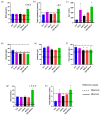Vitamin E (α-Tocopherol) Does Not Ameliorate the Toxic Effect of Bisphenol S on the Metabolic Analytes and Pancreas Histoarchitecture of Diabetic Rats
- PMID: 37505591
- PMCID: PMC10383361
- DOI: 10.3390/toxics11070626
Vitamin E (α-Tocopherol) Does Not Ameliorate the Toxic Effect of Bisphenol S on the Metabolic Analytes and Pancreas Histoarchitecture of Diabetic Rats
Abstract
This study investigated whether the coadministration of vitamin E (VitE) diminishes the harmful effects provoked by plasticizer bisphenol S (BPS) in the serum metabolites related to hepatic and renal metabolism, as well as the endocrine pancreatic function in diabetic male Wistar rats. Rats were divided into five groups (n = 5-6); the first group was healthy rats (Ctrl group). The other four groups were diabetic rats induced with 45 mg/kg bw of streptozotocin: Ctrl-D (diabetic control); VitE-D (100 mg/kg bw/d of VitE); BPS-D (100 mg/kg bw/d of BPS); The animals from the VitE + BPS-D group were administered 100 mg/kg bw/d of VitE + 100 mg/kg bw/d of BPS. All compounds were administered orally for 30 days. Body weight, biochemical assays, urinalysis, glucose tolerance test, pancreas histopathology, proximate chemical analysis in feces, and the activity of antioxidants in rat serum were assessed. The coadministration of VitE + BPS produced weight losses, increases in 14 serum analytes, and degeneration in the pancreas. Therefore, the VitE + BPS coadministration did not have a protective effect versus the harmful impact of BPS or the diabetic metabolic state; on the contrary, it partially aggravated the damage produced by the BPS. VitE is likely to have an additive effect on the toxicity of BPS.
Keywords: biochemistry; bisphenol S; diabetic rats; endocrine-disrupting compounds; vitamin E.
Conflict of interest statement
The authors have no relevant financial or non-financial interest to disclose.
Figures






Similar articles
-
Short- and long-term effect of oral administration of micellized natural vitamin E (D-α-tocopherol) on oxidative status in race horses under intense training.J Anim Sci. 2013 Mar;91(3):1277-84. doi: 10.2527/jas.2012-5125. Epub 2013 Jan 7. J Anim Sci. 2013. PMID: 23296828
-
Serum alpha-tocopherol and immune function in yearling ewes supplemented with zinc and vitamin E.J Anim Sci. 2002 May;80(5):1329-34. doi: 10.2527/2002.8051329x. J Anim Sci. 2002. PMID: 12019622
-
Vitamin E supplementation in beef finishing diets containing 35% wet distillers grains with solubles: feedlot performance and carcass characteristics.J Anim Sci. 2012 Apr;90(4):1349-55. doi: 10.2527/jas.2011-3833. Epub 2011 Dec 6. J Anim Sci. 2012. PMID: 22147485
-
Dietary glycation compounds - implications for human health.Crit Rev Toxicol. 2024 Sep;54(8):485-617. doi: 10.1080/10408444.2024.2362985. Epub 2024 Aug 16. Crit Rev Toxicol. 2024. PMID: 39150724
-
Regulatory and academic studies to derive reference values for human health: The case of bisphenol S.Environ Res. 2022 Mar;204(Pt C):112233. doi: 10.1016/j.envres.2021.112233. Epub 2021 Oct 21. Environ Res. 2022. PMID: 34688643 Review.
Cited by
-
Melatonin and Vitamins as Protectors against the Reproductive Toxicity of Bisphenols: Which Is the Most Effective? A Systematic Review and Meta-Analysis.Int J Mol Sci. 2023 Oct 5;24(19):14930. doi: 10.3390/ijms241914930. Int J Mol Sci. 2023. PMID: 37834378 Free PMC article.
References
-
- Alboghobeish S., Mahdavinia M., Zeidooni L., Samimi A., Oroojan A.A., Alizadeh S., Dehghani M.A., Ahangarpour A., Khorsandi L. Efficiency of naringin against reproductive toxicity and testicular damages induced by bisphenol A in rats. Iran. J. Basic. Med. Sci. 2019;22:315–523. doi: 10.22038/ijbms.2019.29757.7184. - DOI - PMC - PubMed
-
- Karrer C., Roiss T., von Goetz N., Gramec Skledar D., Peterlin Mašič L., Hungerbühler K. Physiologically Based Pharmacokinetic (PBPK) Modeling of the Bisphenols BPA, BPS, BPF, and BPAF with New Experimental Metabolic Parameters: Comparing the Pharmacokinetic Behavior of BPA with Its Substitutes. Environ. Health Perspect. 2018;126:077002. doi: 10.1289/EHP2739. - DOI - PMC - PubMed
LinkOut - more resources
Full Text Sources

